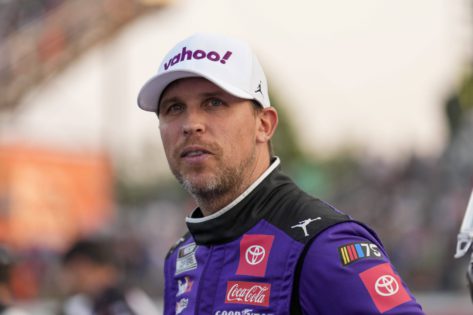When NASCAR unveiled the Next Gen car in 2022, it arrived with promises that echoed through every garage stall on pit road. The revolutionary vehicle was heralded as the great equalizer—a platform that would dramatically cut operating costs while creating more competitive racing. Three years and countless races later, veteran driver and 23XI Racing co-owner Denny Hamlin has pulled back the curtain on what he sees as NASCAR’s unfulfilled promise. As teams now face the additional pressure of new U.S. tariffs affecting parts suppliers, Hamlin’s candid assessment exposes a concerning reality. Far from reducing expenses, the Next Gen era may be making NASCAR less sustainable than ever.
Denny Hamlin occupies a unique position in the sport as both a championship-contending driver for Joe Gibbs Racing and co-owner (with basketball legend Michael Jordan) of the relatively young 23XI Racing organization. This dual perspective provides him uncommon insight into both the competition and business sides of NASCAR—making his recent comments particularly significant for understanding the sport’s economic health.
During a recent interview, Denny Hamlin was asked about the potential impact of newly implemented tariffs on NASCAR teams. His response went beyond the immediate tariff concern to address a deeper issue that has been brewing since the Next Gen car’s introduction.
“Um, I mean as a team owner, yeah,” Hamlin acknowledged when asked about cost concerns. “There’s vendors that are saying that they’re going to have to raise their prices, and again, the cost of Next Gen itself has gotten so high in general. I’m sure it would fall—it’s going to fall on the teams like you would think.” This stark assessment directly contradicts NASCAR’s original selling point that the standardized parts and single-source supplier model would make racing more economically sustainable.
The rising costs Denny Hamlin references are particularly concerning in light of NASCAR Commissioner Steve Phelps’ recent statements. On NASCAR’s Hauler Talk podcast, Phelps admitted uncertainty about how the new 25% tariffs might affect teams sourcing parts: “It’s something that we are obviously going to watch very closely… It’s an unknown.” Sports Business Journal previously reported that the Next Gen car relies on 26 single-source suppliers for critical components, including UK-based AP Racing for brake systems—exactly the type of international supply chain relationships now threatened by increased tariffs.
NASCAR, Motorsport, USA Cook Out Southern 500 Sep 3, 2023 Darlington, South Carolina, USA Crew members work on NASCAR Cup Series driver Christopher Bell 20 car during the NASCAR Cook Out Southern 500 at Darlington Raceway. Darlington Darlington Raceway South Carolina USA, EDITORIAL USE ONLY PUBLICATIONxINxGERxSUIxAUTxONLY Copyright: xDavidxYeazellx 20230903_ams_be3_0208
These compounding factors create a financial storm for NASCAR organizations. The powerhouse teams like Hendrick Motorsports (whose owner Rick Hendrick was specifically mentioned by Phelps as monitoring tariff impacts “on a daily basis”) might weather these increased expenses. But the situation appears particularly dire for smaller operations—precisely the teams the Next Gen car was supposed to help. But even a legacy team like HMS hasn’t turned a profit in the last 10 years, so you can only imagine how the new tariff could sweep the NASCAR garage with rising costs.
Small Teams Face the Brunt as History Repeats Itself
In 2003, when Toyota first announced its entry into NASCAR’s Craftsman Truck Series, the racing world faced remarkably similar economic challenges to today’s situation. Then, as now, a 25% tariff on imported vehicles created waves throughout the motorsport ecosystem. According to economist Ray Keating’s October 2003 analysis, this tariff was originally imposed in 1963 as retaliation for “unfair tariff treatment of U.S. chicken exports” — yet it remained in place decades later, affecting manufacturing costs and team operations. Today’s identical 25% tariff rate mirrors this economic pressure point, suggesting NASCAR teams are reliving a familiar financial squeeze.
The debate around “American-made” racing vehicles that dominated headlines in 2003 has transformed into today’s concerns about global supply chains for Next Gen components. Twenty years ago, Keating highlighted how 32 different foreign nameplate vehicles were being produced in the United States, blurring traditional definitions of domestic manufacturing. The Next-Gen car has further complicated this picture, with NASCAR’s 26 single-source suppliers now scattered globally, including UK-based AP Racing for brake systems. Then, automotive giants held controlling interests in foreign manufacturers (General Motors owned 49 per cent of Isuzu, 20 per cent of Fuji Heavy Industries, which produced Subaru, and 20 per cent of Suzuki. Ford had a 33.4 per cent share of Mazda, and DaimlerChrysler owned 37.3 per cent of Mitsubishi.) Today, those international relationships have evolved into complex parts supply networks vulnerable to the same tariff disruptions.
The economic comparisons present severe challenges to small team operations. Keating predicted in 2003 that trade barriers worked against competition and choices and forced diplomacy failures by showing the U.S. “look rather foolish when we preach the benefits of free trade.“. According to Hamlin, the standardized Next Gen car has unexpectedly introduced a new discrimination because team development costs are increasing instead of reaching their promised purpose to equalize competition. Toyota adopts a strategy to “maintain operations” coupled while “reducing fixed costs” under tariff conditions which creates economic stress for smaller race teams.
Not to forget, NASCAR, in the meantime also has to deal with the anti-trust lawsuit filed by 23XI Racing and FRM over the charter dispute. So, the sport is going through a major financial shift, which could make or break their ambitious plans to expand beyond the traditional borders.
The post Denny Hamlin Exposes NASCAR’s Biggest Lie on Next-Gen Cars in Huge Revelation After 3 Years appeared first on EssentiallySports.
